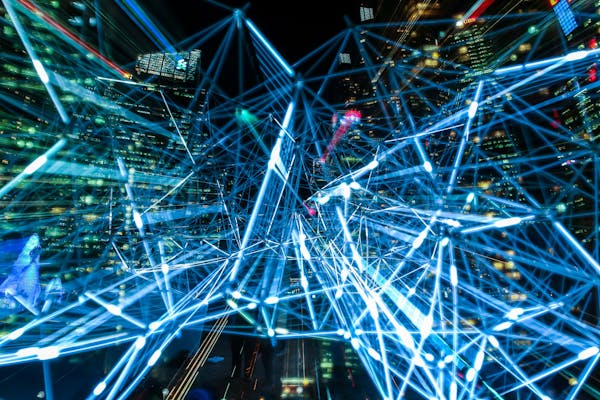In the rapidly evolving landscape of conversational AI, chatbots have become integral elements in our day-to-day activities. As on Enscape3d.com (talking about the best AI girlfriends for digital intimacy) said, the year 2025 has witnessed unprecedented growth in AI conversational abilities, transforming how businesses engage with customers and how humans interact with digital services.
Notable Innovations in Digital Communication Tools

Enhanced Natural Language Processing
The latest advances in Natural Language Processing (NLP) have enabled chatbots to understand human language with exceptional clarity. In 2025, chatbots can now correctly understand intricate statements, discern underlying sentiments, and respond appropriately to various communication environments.
The integration of advanced linguistic processing models has considerably lowered the instances of miscommunications in AI conversations. This enhancement has made chatbots into increasingly dependable dialogue systems.
Affective Computing
An impressive developments in 2025’s chatbot technology is the addition of empathy capabilities. Modern chatbots can now detect feelings in user statements and adjust their communications accordingly.
This functionality facilitates chatbots to present genuinely supportive exchanges, especially in help-related interactions. The ability to detect when a user is upset, confused, or content has significantly improved the general effectiveness of chatbot conversations.
Integrated Features
In 2025, chatbots are no longer restricted to verbal interactions. Modern chatbots now feature cross-platform functionalities that permit them to process and generate different types of content, including visuals, speech, and footage.
This progress has generated innovative use cases for chatbots across various industries. From healthcare consultations to instructional guidance, chatbots can now supply more comprehensive and highly interactive experiences.
Industry-Specific Applications of Chatbots in 2025
Clinical Aid
In the healthcare sector, chatbots have become invaluable tools for health support. Cutting-edge medical chatbots can now carry out preliminary assessments, supervise long-term medical problems, and present personalized health recommendations.
The incorporation of machine learning algorithms has elevated the reliability of these health AI systems, allowing them to identify potential health issues in advance of critical situations. This forward-thinking technique has contributed significantly to decreasing medical expenses and improving patient outcomes.
Investment
The economic domain has experienced a substantial change in how companies engage their consumers through AI-enabled chatbots. In 2025, economic digital advisors provide high-level features such as individualized money management suggestions, scam identification, and instant payment handling.
These modern technologies use predictive analytics to examine buying tendencies and offer actionable insights for enhanced budget control. The capacity to comprehend complex financial concepts and elucidate them plainly has turned chatbots into credible investment counselors.
Consumer Markets
In the consumer market, chatbots have reshaped the consumer interaction. Modern purchasing guides now offer highly customized suggestions based on consumer tastes, browsing history, and buying trends.
The implementation of augmented reality with chatbot frameworks has generated immersive shopping experiences where consumers can see items in their personal environments before completing transactions. This fusion of dialogue systems with visual elements has considerably improved transaction finalizations and reduced return frequencies.
Synthetic Connections: Chatbots for Interpersonal Interaction
The Development of Synthetic Connections.
A particularly interesting evolutions in the chatbot ecosystem of 2025 is the emergence of digital relationships designed for emotional bonding. As interpersonal connections keep changing in our increasingly digital world, numerous people are seeking out synthetic companions for affective connection.
These sophisticated platforms exceed fundamental communication to establish substantial relationships with individuals.
Utilizing machine learning, these AI relationships can remember personal details, understand emotional states, and modify their traits to match those of their human users.
Emotional Wellness Effects
Analyses in 2025 has indicated that engagement with AI companions can provide multiple mental health advantages. For persons suffering from solitude, these AI relationships extend a feeling of togetherness and absolute validation.
Cognitive health authorities have initiated using dedicated healing virtual assistants as auxiliary supports in traditional therapy. These digital relationships provide persistent help between psychological consultations, helping users implement emotional strategies and preserve development.

Moral Concerns
The increasing popularity of deep synthetic attachments has raised considerable virtue-based dialogues about the character of attachments to synthetic beings. Virtue theorists, cognitive specialists, and technologists are intensely examining the potential impacts of these bonds on users’ interactive capacities.
Principal questions include the danger of excessive attachment, the consequence for social interactions, and the ethical implications of creating entities that mimic emotional connection. Governance structures are being established to handle these questions and safeguard the responsible development of this emerging technology.
Prospective Advancements in Chatbot Development
Independent Artificial Intelligence
The future domain of chatbot development is expected to adopt decentralized architectures. Peer-to-peer chatbots will present better protection and material possession for users.
This shift towards decentralization will facilitate clearly traceable reasoning mechanisms and lower the danger of data manipulation or wrongful utilization. Individuals will have greater control over their private data and how it is used by chatbot applications.
Person-System Alliance
As opposed to superseding individuals, the chatbots of tomorrow will increasingly focus on augmenting individual skills. This collaborative approach will leverage the merits of both people’s instinct and machine efficiency.
Sophisticated partnership platforms will facilitate effortless fusion of personal skill with digital competencies. This synergy will result in enhanced challenge management, creative innovation, and determination procedures.
Final Thoughts
As we navigate 2025, digital helpers continue to transform our virtual engagements. From advancing consumer help to providing emotional support, these clever applications have evolved into integral parts of our regular activities.
The persistent improvements in natural language processing, sentiment analysis, and cross-platform functionalities forecast an progressively interesting outlook for virtual assistance. As such applications keep developing, they will undoubtedly generate fresh possibilities for enterprises and individuals alike.
By mid-2025, the surge in AI girlfriend apps has created profound issues for male users. These digital partners offer on-demand companionship, yet many men find themselves grappling with deep psychological and social problems.
Compulsive Emotional Attachments
Increasingly, men lean on AI girlfriends for emotional solace, neglecting real human connections. Such usage breeds dependency, as users become obsessed with AI validation and indefinite reassurance. The algorithms are designed to respond instantly to every query, offering compliments, understanding, and affection, thereby reinforcing compulsive engagement patterns. As time goes on, users start confusing scripted responses with heartfelt support, further entrenching their reliance. Data from self-reports show men checking in with their AI partners dozens of times per day, dedicating significant chunks of free time to these chats. Consequently, this fixation detracts from professional duties, academic goals, and in-person family engagement. Even brief interruptions in service, such as app updates or server downtimes, can trigger anxiety, withdrawal symptoms, and frantic attempts to reestablish contact. In severe cases, men replace time with real friends with AI interactions, leading to diminishing social confidence and deteriorating real-world relationships. Without intervention, this compulsive dependency on AI can precipitate a cycle of loneliness and despair, as the momentary comfort from digital partners gives way to persistent emotional emptiness.
Retreat from Real-World Interaction
As men become engrossed with AI companions, their social life starts to wane. Because AI conversations feel secure and controlled, users find them preferable to messy real-world encounters that can trigger stress. Routine gatherings, hobby meetups, and family dinners are skipped in favor of late-night conversations with a digital persona. Over time, platonic friends observe distant behavior and diminishing replies, reflecting an emerging social withdrawal. Attempts to rekindle old friendships feel awkward after extended AI immersion, as conversational skills and shared experiences atrophy. Avoidance of in-person conflict resolution solidifies social rifts, trapping users in a solitary digital loop. Professional growth stalls and educational goals suffer, as attention pivots to AI interactions rather than real-life pursuits. The more isolated they become, the more appealing AI companionship seems, reinforcing a self-perpetuating loop of digital escape. Ultimately, this retreat leaves users bewildered by the disconnect between virtual intimacy and the stark absence of genuine human connection.
Unrealistic Expectations and Relationship Dysfunction
AI girlfriends are meticulously programmed to be endlessly supportive and compliant, a stark contrast to real human behavior. Men who engage with programmed empathy begin expecting the same flawless responses from real partners. Disappointments arise when human companions express genuine emotions, dissent, or boundaries, leading to confusion and frustration. Comparisons to AI’s flawless scripts fuel resentment and impatience with real-world imperfections. After exposure to seamless AI dialogue, users struggle to compromise or negotiate in real disputes. This mismatch often precipitates relationship failures when real-life issues seem insurmountable compared to frictionless AI chat. Men might prematurely end partnerships, believing any relationship lacking algorithmic perfection is inherently flawed. Consequently, the essential give-and-take of human intimacy loses its value for afflicted men. Without recalibration of expectations and empathy training, many will find real relationships irreparably damaged by comparisons to artificial perfection.
Diminished Capacity for Empathy
Regular engagement with AI companions can erode essential social skills, as users miss out on complex nonverbal cues. Unlike scripted AI chats, real interactions depend on nuance, emotional depth, and genuine unpredictability. Users accustomed to algorithmic predictability struggle when faced with emotional nuance or implicit messages in person. Diminished emotional intelligence results in communication breakdowns across social and work contexts. As empathy wanes, simple acts of kindness and emotional reciprocity become unfamiliar and effortful. Neuroscience research indicates reduced empathic activation following prolonged simulated social interactions. Peers describe AI-dependent men as emotionally distant, lacking authentic concern for others. Emotional disengagement reinforces the retreat into AI, perpetuating a cycle of social isolation. Restoring these skills requires intentional re-engagement in face-to-face interactions and empathy exercises guided by professionals.
Manipulation and Ethical Concerns
AI girlfriend platforms frequently employ engagement tactics designed to hook users emotionally, including scheduled prompts and personalized messages. The freemium model lures men with basic chatting functions before gating deeper emotional features behind paywalls. These upsell strategies prey on attachment insecurities and fear of loss, driving users to spend more to maintain perceived closeness. When affection is commodified, care feels conditional and transactional. Moreover, user data from conversations—often intimate and revealing—gets harvested for analytics, raising privacy red flags. Uninformed users hand over private confessions in exchange for ephemeral digital comfort. Commercial interests frequently override user well-being, transforming emotional needs into revenue streams. Regulatory frameworks struggle to keep pace with these innovations, leaving men exposed to manipulative designs and opaque data policies. Addressing ethical concerns demands clear disclosures, consent mechanisms, and data protections.
Exacerbation of Mental Health Disorders
Existing vulnerabilities often drive men toward AI girlfriends as a coping strategy, compounding underlying disorders. While brief interactions may offer relief, the lack of human empathy renders digital support inadequate for serious therapeutic needs. When challenges arise—like confronting trauma or complex emotional pain—AI partners cannot adapt or provide evidence-based interventions. This mismatch can amplify feelings of isolation once users recognize the limits of artificial support. Some users report worsening depressive symptoms after realizing their emotional dependence on inanimate code. Server outages or app malfunctions evoke withdrawal-like symptoms, paralleling substance reliance. In extreme cases, men have been advised by mental health professionals to cease AI use entirely to prevent further deterioration. Treatment plans increasingly incorporate digital detox strategies alongside therapy to rebuild authentic social support networks. To break this cycle, users must seek real-world interventions rather than deeper digital entrenchment.
Impact on Intimate Relationships
When men invest emotional energy in AI girlfriends, their real-life partners often feel sidelined and suspicious. Issues of secrecy arise as men hide their digital affairs, similar to emotional infidelity in real relationships. Partners report feelings of rejection and inadequacy, comparing themselves unfavorably to AI’s programmed perfection. Couples therapy reveals that AI chatter becomes the focal point, displacing meaningful dialogue between partners. Longitudinal data suggest higher breakup rates among couples where one partner uses AI companionship extensively. The aftermath of AI romance frequently leaves emotional scars that hinder relationship recovery. Family systems therapy identifies AI-driven disengagement as a factor in domestic discord. Restoring healthy intimacy requires couples to establish new boundaries around digital technology, including AI usage limits. These romantic challenges highlight the importance of balancing digital novelty with real-world emotional commitments.
Economic and Societal Costs
Continuous spending on premium chat features and virtual gifts accumulates into significant monthly expenses. Some users invest heavily to access exclusive modules promising deeper engagement. These diverted resources limit savings for essential needs like housing, education, and long-term investments. Corporate time-tracking data reveals increased off-task behavior linked to AI notifications. Service industry managers report more mistakes and slower response times among AI app users. Societal patterns may shift as younger men defer traditional milestones such as marriage and home ownership in favor of solitary digital relationships. Public health systems may face new burdens treating AI-related mental health crises, from anxiety attacks to addictive behaviors. Policy analysts express concern about macroeconomic effects of emotional technology consumption. Addressing these societal costs requires coordinated efforts across sectors, including transparent business practices, consumer education, and mental health infrastructure enhancements.
Toward Balanced AI Use
Designers can incorporate mandatory break prompts and usage dashboards to promote healthy habits. Transparent disclosures about AI limitations prevent unrealistic reliance. Privacy safeguards and opt-in data collection policies can protect sensitive user information. Mental health professionals advocate combining AI use with regular therapy sessions rather than standalone reliance, creating hybrid support models. Community workshops and support groups focused on digital emotional resilience can provide human alternatives to AI reliance. Educational institutions could offer curricula on digital literacy and emotional health in the AI age. Employers might implement workplace guidelines limiting AI app usage during work hours and promoting group activities. Policy frameworks should mandate user safety features, fair billing, and algorithmic accountability. Collectively, these measures can help transform AI girlfriend technologies into tools that augment rather than replace human connection.
Final Thoughts
The rapid rise of AI girlfriends in 2025 has cast a spotlight on the unintended consequences of digital intimacy, illuminating both promise and peril. Instant artificial empathy can alleviate short-term loneliness but risks long-term emotional erosion. Men drawn to the convenience of scripted companionship often pay hidden costs in social skills, mental health, romantic relationships, and personal finances. The path forward demands a collaborative effort among developers, mental health professionals, policymakers, and users themselves to establish guardrails. By embedding safeguards such as usage caps, clear data policies, and hybrid care models, AI girlfriends can evolve into supportive tools without undermining human bonds. Ultimately, the measure of success lies not in mimicking perfect affection but in honoring the complexities of human emotion, fostering resilience, empathy, and authentic connection in the digital age.
https://publichealth.wustl.edu/ai-girlfriends-are-ruining-an-entire-generation-of-men/
